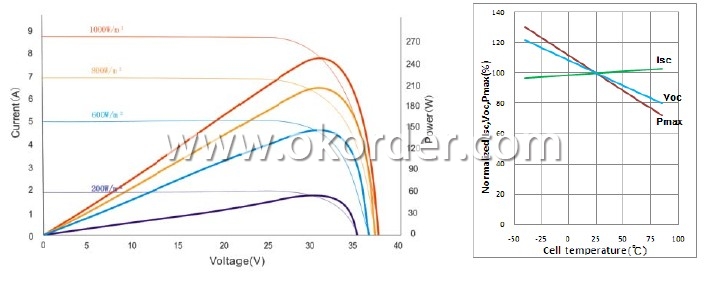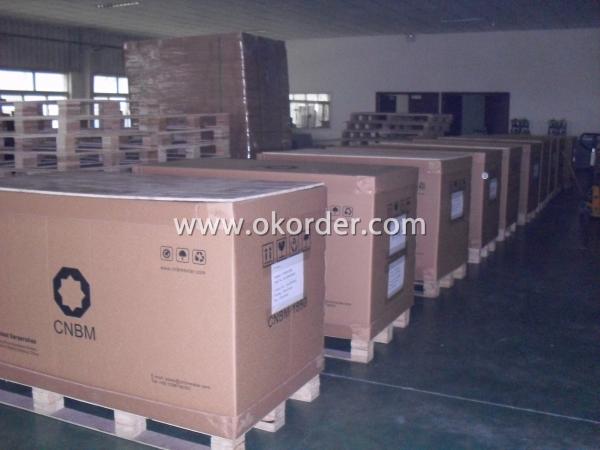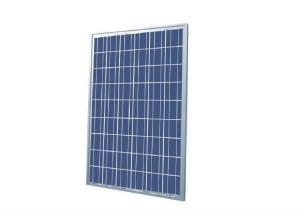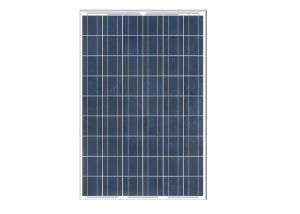Poly Solar Panels CNBM 205W
- Loading Port:
- China Main Port
- Payment Terms:
- TT or LC
- Min Order Qty:
- 1 pc watt
- Supply Capability:
- 10000 pcs per month watt/month
OKorder Service Pledge
OKorder Financial Service
You Might Also Like
Introduction of Poly Solar Panels CNBM (205W)
CNBM Solar photovoltaic (PV) Panel is designed for large electrical power requirements. It is the optimal choice for both on-grid and off-grid power systems. CNBM Solar panel offers high performance of power per square foot of solar array. Monocrystalline silicon(c-Si): often made using the Czochralski process. Single-crystal wafer cells tend to be expensive, and because they are cut from cylindrical ingots, do not completely cover a square solar cell module without a substantial waste of refined silicon. Hence most c-Si panels have uncovered gaps at the four corners of the cells.
Characteristics of Poly Solar Panels CNBM (205W)
I.Solar Cell : High efficiency crystalline solar cell. Even if under the weak light, the solar module can produce maximum power output.
II.Tempered glass (toughened glass): Anti-reflecting coating and high transmission rate glass increase the power output and mechanical strength of solar module.
III.EVA and TPT: Using high quality EVA and TPT to prevent destroying and water.
IV.AI frame: Without screw, corner connection. 6 holes on the frame can be installed easily.
V.Junction box: Multi function junction box with water proof.
VI.Long lifetime: ≥25 years; Less power decrease.
VII.Good performance of preventing from atrocious weather such as wind and hails.
VIII.Resisting moisture and etching effectively, not effected by geology.
IX.The certificate issued by international authority: UL, TUV, IEC, VDE, CE.
Standard Test Conditions of Poly Solar Panels CNBM (205W)
The opto-electrical specifications shown below are stabilized values being measured at Standard Test Conditions, Irradiance: 1000W/m2, Spectrum: AM1.5 at 25°C, The info below is subject to manufacturing tolerances. Where appropriate minutes of measurement are available and are used for the dimensioning of the installation.
Advantages of Poly Solar Panels CNBM (205W)
• CNBM Solar performance guarantees for 25 years
• 10 years guarantee for workmanship
• Timeliness of delivery
• Quality Products certified (TÜV, UL, CE, VDE, ISO)
CNBM International Corporation's products including Monocrystalline Solar Panel, Polycrystalline Solar Panel have received and enjoyed famous reputation in many countries and regions in the world .As a solar panel manufacturer in China, we strive to provide our customers with excellent service, superior products and unmatched value.
Datasheet of Poly Solar Panels CNBM (205W)
Characteristics of Poly Solar panels CNBM (205W) | |
Max Power Voltage Vmp(V) | 27 |
Max Power Current Imp(A) | 7.6 |
Open Circuit Voltage Voc(V) | 33 |
Short Circuit Current Isc(A) | 8.28 |
Max Power Pm(W) | 205W |
Temperature Coefficient of Cells Poly Solar Panels CNBM (205W) | |
NOCT | 45℃ ± 2℃ |
Temperature Coeffucients of Isc (%/℃) | 0.0825 |
Temperature Coeffucients of Voc (%/℃) | -0.4049 |
Temperature Coeffucients of Voc (%/℃) | -0.4336 |
Mechanical Data of Poly Solar Panels CNBM (205W) | |
Dimension | 1482 × 992 × 40 mm |
Weight | 27 kg |
No. of Cells and Connections | 54 (6 ×9) |
Tolerance | 0 ~ + 5 W |
Cell | Monocrystalline Cell 156 × 156 mm |
Packing | 720 Pcs/40ft(H) Container |
Limits of Poly Solar Panels CNBM (205W) | |
Operating Temperature | -40℃ to +85℃ |
Storage Temperature | -40℃ to +85℃ |
Max System Voltage | 1000VDC(IEC) / 600VDC(UL) |
Guarantees of Poly Solar Panels CNBM (205W) | |
Products Guarantee | 10 yrs free from defects in materials and workmanship |
Performance Guarantee | No less than 90% within 10yrs and no less than 80% within 25yrs |
Certificates | TUV(IEC61215&IEC61730),VDE(IEC61215&IEC61730),UL,CE |
IV Curve of Poly Solar Panels CNBM (205W)

The data does not refer to a single module and it is not part of the offer
It is only for comparison only to different module types.
Test Conditions of Poly Solar Panels CNBM (205W)
The opto-electrical specifications shown below are stabilized values being measured at Standard Test Conditions, Irradiance: 1000W/m2, Spectrum: AM1.5 at 25°C, The info below is subject to manufacturing tolerances. Where appropriate minutes of measurement are available and are used for the dimensioning of the installation.
Picture 1. The factory indoor sight of Poly Solar Panels CNBM (205W)

Picture 2 the package of Poly Solar Panels CNBM (205W)

- Q:Can solar panels be installed in urban areas?
- Yes, solar panels can be installed in urban areas. In fact, urban areas provide great opportunities for solar panel installations due to the abundance of rooftop space and potential to generate clean energy in densely populated areas.
- Q:Can solar panels be used in areas with high levels of pollution from transportation?
- Yes, solar panels can still be used in areas with high levels of pollution from transportation. While pollution can potentially reduce the efficiency of solar panels by blocking sunlight and depositing dirt or particles on their surface, advancements in technology and regular maintenance can help mitigate these effects. Additionally, installing solar panels can contribute to reducing overall pollution levels by transitioning to clean energy sources.
- Q:Can anyone give me some info on how to figure how many panels needed for a 0 volt 2 amp pool motor. Thanks/ Run 5 hours a day
- I don't think heating a 70,000 gallon pool with solar panels is practical. My husband has designed and built our solar hot water system. It works quite well. We live in Arizona. There's no way we could heat that much water using sun energy. You have to heat the water and compete with the outside air.
- Q:What is the average payback period for solar panels?
- The average payback period for solar panels is typically between 6 to 10 years. However, this can vary depending on various factors such as the initial cost of installation, location, energy consumption, government incentives, and local electricity rates.
- Q:Are solar panels affected by shade?
- Yes, solar panels are affected by shade. Shading can significantly reduce the efficiency and overall energy production of solar panels. It is important to ensure that solar panels are installed in areas with minimal shade to maximize their performance.
- Q:Are solar panels fire hazards?
- Solar panels themselves are not fire hazards. However, if there is a faulty installation, damage, or improper maintenance, there is a slight risk of fire. Regular inspections and adherence to safety guidelines greatly minimize this risk, making solar panels generally safe and reliable.
- Q:Can solar panels be damaged by hail or strong winds?
- Yes, solar panels can be damaged by hail or strong winds. Hail can cause physical damage to the panels, such as cracking or shattering the glass surface. Strong winds can potentially dislodge or loosen the panels, leading to structural damage or detachment. To mitigate these risks, solar panels are designed and installed to withstand certain weather conditions, but extreme hail or exceptionally strong winds can still cause damage.
- Q:Do I need some type of regulator when the batteries are fully charged.?? The Arco Panels voltage is approx 7VDC at 2.5 amps, Should I limited the voltage to 4VDC???. I would like to connect both panels to up to five batteries at one time...???
- You can buy Solar Charger Regulators. I don't. These chargers limit the charging current to the batteries, so you do not get a full efficiency of the solar panel. They disconnect the batteries from the user side (the bulbs you use) if the battery voltage goes below a certain level (i.e. below 8V for a 2V battery), so you cannot use all the power available in the batteries, even in emergency. They introduce, at least, a 0.7V loss (diode forward voltage) between the panel and the battery. If you have SEVERAL panels and a lot of batteries, use a controller as above. If you only have one panel, insert a 5A trip fuse in line (in your case: twice the current of the panel), and a 0-20A diode in series between the panel and the batteries (Kathode side of the + of the battery, Anode side of the + of the panel). Install a voltmeter across the battery. The fuse will prevent any short or over-charge current. The diode will prevent the battery to discharge into the panel at night if it is not already protected. The voltmeter will allow you to watch the status. Your thought of limiting the voltage is useless: should the battery be low, the panel will drop its voltage, limited by the max current. Should the battery be fully charged and the solar panel at full efficiency, it will just try to charge the battery more. A bit of bubbles may result, hence the voltmeter to watch over it. If you want to limit the voltage to 4V, put a 4V Zener (4Vx2.5W!) in series with a resistor of, say, 7V-4V/2.5A or ~ Ohm, 5W, in parallel with the panel.
- Q:Can solar panels be installed on a billboard or signage?
- Yes, solar panels can be installed on billboards or signage.
- Q:I need to power a series of meraki wireless repeaters that plug into a standerd wall outlet. consuming 5v or .08 amps However I need this in a remote location (like out in the middle of nowhere) Using A solar panel as power supply and a battery to store the energy but, how and what do I use to convert the energy coming from the solar panel to the battery and the batteries power supply to match the needs of the meraki wireless repeater? How do I make this as compact as possible? Do I need a ac/dc converter? or dc/ac converter? Any suggestions or solutions would be great !
- First things first. 5 Volts @ .08 amps would be .2 Watts. therefore you would need at least the same amount from a solar panel to replenish the batteries. But what puzzles me is the notion that plugging it in a wall outlet ? If you use 20 V @ 0.08 then the power consumption is 9.6 Watts And what is a meraki wireless repeater? I never heard of one. I'm a FCC licensed Ham and have some idea what is available. If you need 5 volts DC, you could use twelve Ni-cads in series and just keep them trickle charged with the solar panel That would make it compact. If you were to use an automotive battery (or motorcycle), then you would need a DC/DC converter.
1. Manufacturer Overview |
|
|---|---|
| Location | Jiangsu, China |
| Year Established | 2004 |
| Annual Output Value | Below US$1 Million |
| Main Markets | Australia;Asia;South East Asia; South America;North America; Europe;Africa |
| Company Certifications | ISO 9001:2008; CE; TUV; UL |
2. Manufacturer Certificates |
|
|---|---|
| a) Certification Name | |
| Range | |
| Reference | |
| Validity Period | |
3. Manufacturer Capability |
|
|---|---|
| a)Trade Capacity | |
| Nearest Port | Shanghai |
| Export Percentage | 1% - 10% |
| No.of Employees in Trade Department | 200-300 People |
| Language Spoken: | English;Chinese |
| b)Factory Information | |
| Factory Size: | Above 8,000 Square meter |
| No. of Production Lines | 6 |
| Contract Manufacturing | OEM Service Offered;Design Service Offered |
| Product Price Range | Average |
Send your message to us
Poly Solar Panels CNBM 205W
- Loading Port:
- China Main Port
- Payment Terms:
- TT or LC
- Min Order Qty:
- 1 pc watt
- Supply Capability:
- 10000 pcs per month watt/month
OKorder Service Pledge
OKorder Financial Service
Similar products
New products
Hot products
Related keywords





























